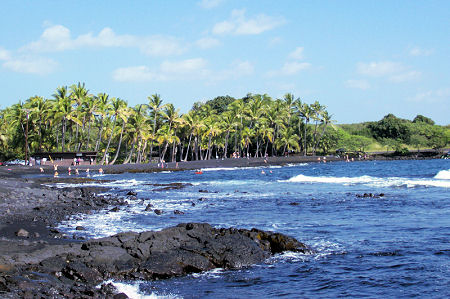A (hopefully) day-to-day chronicle of life as we discover, the good, the bad and the unbelievably fantastic parts of raising two daughters.
Wednesday, February 9, 2011
Big Island Wednesday: Punalu'u Black Sand Beach
Black sand beaches can be found all over the Big Island of Hawaii, but Punalu'u Beach, located on the island's southeast shore, is the most popular and one of the most beautiful. This beach is easily accessible and boasts a shore of shiny, jet black sand, mostly made up of ground basalt. It was created by lava flowing into the ocean. The area is a well-known nesting place for hawksbill and green sea turtles, both endangered species and the target of many conservation efforts.
On a regular day, the shore is dotted with large sea turtles playing and catching some sun. At one end of the beach is a natural freshwater pool perfect for wading and cooling down. Further offshore, there are numerous underground freshwater springs, which are very cold and mix with the ocean water. In the past, the people who lived in this area would dive underwater with bottles to obtain freshwater. They pressed their fingers on the water bottles, dove down, and when they reached the freshwater springs, they removed their fingers and filled the bottles. In the Hawaiian language, Punaluu means “diving spring.”
Legend has it that anyone who takes a stone from this beach will be cursed by the volcano goddess Pele and be forgiven only when the stone is returned. However, while this is supposedly an ancient Hawaiian legend, historians were only able to trace the origins of this legend to the mid-twentieth century. It is believed that park rangers invented it to prevent visitors from taking rocks and sand home.
Nevertheless, if you visit the lobby of the Kilauea Military Camp, you'll see a cabinet where rocks are displayed that have been mailed back to Hawaii by people who had taken them and who were haunted by bad luck ever since. Their letters explaining their predicaments are on display as well.
In the past, Punaluu has suffered severe erosion by the ocean. In 1868, a huge tsunami that was caused by an earthquake struck the area. Waves as high as the coconut trees suddenly rolled in and leveled every shoreline village from South Point to Kumukahi. The residents later rebuilt the village at Punaluu and in the 1880s, a pier was built to move the harvested sugar cane from the surrounding plantations via interisland steamships. But when more roads were built and automobiles were available to transport goods, the Punaluu shipping point was abandoned and Hilo became the Big Island’s main port. The area was hit by two other tsunamis in 1960 and 1975.
The best part to enter the ocean at Punaluu is at the northeastern end of the beach because there are fewer lava rocks at the water’s edge. There is also a small boat ramp in this area, next to the ruins of the old pier. Swimmers should keep in mind that there is a strong rip current that runs out the boat channel into the open ocean. So it is best to stay away from the northeastern point of the bay.
Subscribe to:
Post Comments (Atom)



No comments:
Post a Comment